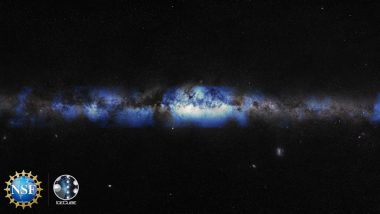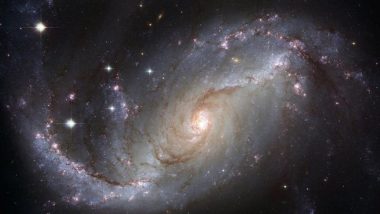New York, June 30: An international group of more than 350 scientists has found new evidence of high-energy neutrino -- tiny and ghostlike astronomical messengers -- emission from the Milky Way galaxy.
The findings, published in the journal Science, indicate that the Milky Way produces far fewer neutrinos than the average distant galaxies. Launcher Orbiter Spacecraft Faces Software Glitch, American Aerospace Company Loses Another Vehicle After Lift Off.
Scientists Capture 1st ‘Ghost Particle’ Image of Milky Way Galaxy
“Ghost Particle” Image Shows The Milky Way Like We've Never Seen Before. https://t.co/RPAvTaHtuM pic.twitter.com/vrbcOUweW0
— Marvelous Marvin ™ (@realmdlykins) June 29, 2023
“Seeing our galaxy with neutrinos is something that we dreamed of, but which seemed out of reach for our project for many years to come,” said Chad Finley, Associate Professor at Stockholm University in Sweden.
“What made this result possible today is the revolution in Machine Learning, allowing us to explore much deeper into our data than before,” Finley added.
The high-energy neutrinos, with energies millions to billions of times higher than those produced by the fusion reactions that power stars, were detected by the IceCube Neutrino Observatory, a gigaton detector operating at the Amundsen-Scott South Pole Station.
The immense observatory detects the subtle signs of high-energy neutrinos from space by using 5,000 networked sensors buried deep within a cubic kilometre of clear, pristine Antarctic ice.
IceCube searches for signs of high-energy neutrinos originating from our galaxy and beyond, out to the farthest reaches of the universe.
The search focused on the southern sky, where the bulk of neutrino emission from the galactic plane is expected near the centre of the galaxy. "What's intriguing is that, unlike the case for light of any wavelength, in neutrinos, the universe outshines the nearby sources in our own galaxy," said Francis Halzen, a physicist at the University of Wisconsin-Madison and principal investigator at IceCube.
The dataset used in the study included 60,000 neutrinos spanning 10 years of IceCube data, 30 times as many events as the selection used in a previous analysis of the galactic plane using cascade events.
These neutrinos were compared to previously published prediction maps of locations in the sky where the galaxy was expected to shine in neutrinos.
The maps included one made from extrapolating Fermi Large Area Telescope gamma-ray observations of the Milky Way and two alternative maps identified as KRA-gamma by the group of theorists who produced them. ISRO to Collaborate With NASA to Establish International Space Station by 2024, Announces Finance Minister Nirmala Sitharaman.
“High-energy neutrinos provide us with a wonderful new tool for studying the Milky Way. The next step is to identify the neutrino sources, potentially the sites for galactic cosmic ray acceleration” said Olga Botner, senior professor at Uppsala University in Sweden.
“If realised, the planned IceCube-Gen2 would enable a deeper yet exploration of the galactic plane, allowing us to distinguish between various source distributions and models for cosmic ray propagation.”
(The above story first appeared on LatestLY on Jun 30, 2023 05:18 PM IST. For more news and updates on politics, world, sports, entertainment and lifestyle, log on to our website latestly.com).













 Quickly
Quickly





















